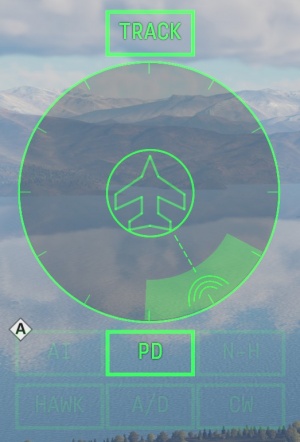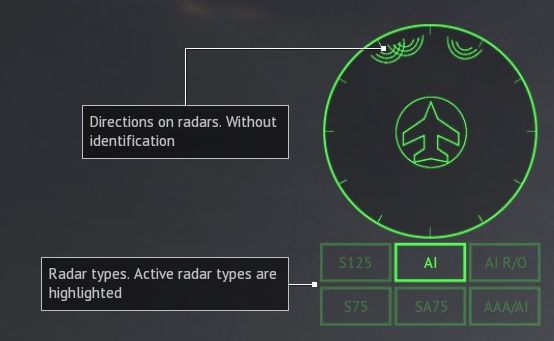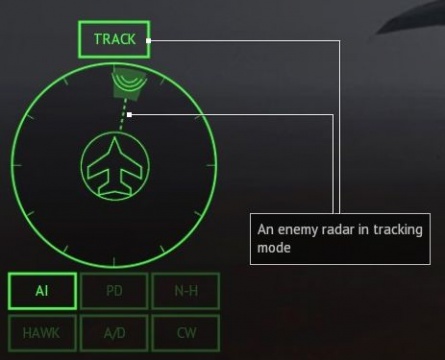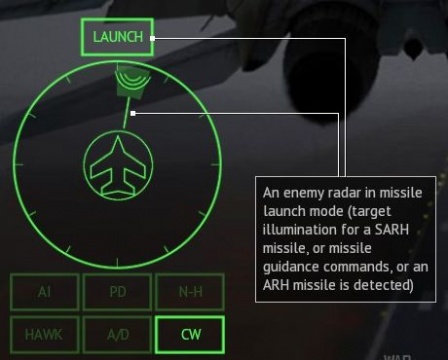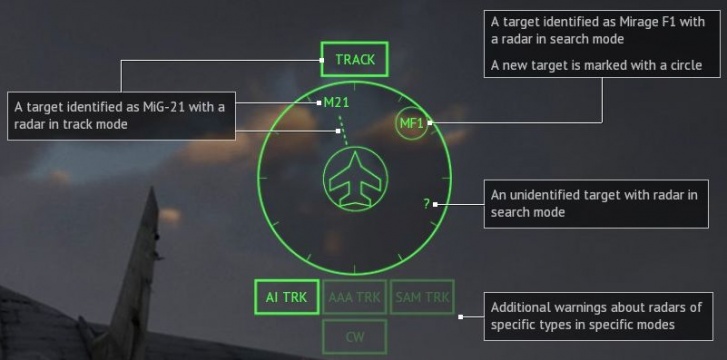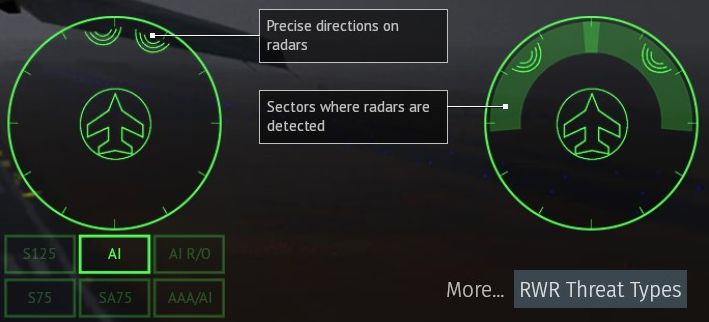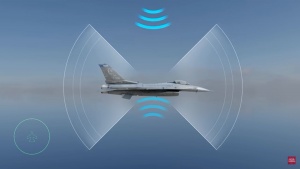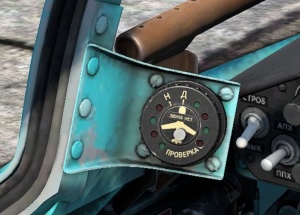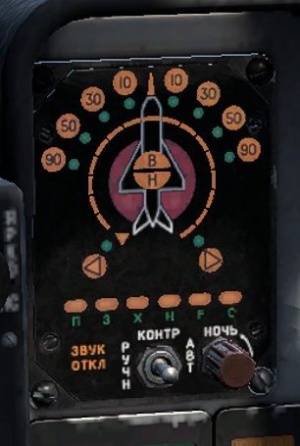Radar warning receiver
A Radar Warning Receiver (RWR) is a system that informs the pilot about incoming radar radiation, allowing for proper action if needed. In-game, the RWR varies a lot between models, but most of them are a clock display which shows the type of threat (search radar or tracking radar), the source, and the direction.
Understanding the RWR

Note: Radar Warning Receivers are only capable of detecting certain bands. Radars that operate at frequencies outside of those bands will not be detected.
Basic function
The RWR warns the pilot about any outside radar that may be detecting, tracking, or launching a radar-guided missile at the user's aircraft, as long as the threat isn't in the RWR's blindspots (often directly above or below).
If a radar is sending a single "ping" at you (a search radar is detecting you), the RWR will sound a short warning and show the direction it is coming from. RWR can show multiple pings at once from different directions and sources. If you hear a constant alarm and see a dashed line coming from the ping towards the center of the RWR, a tracking radar has locked you and is constantly tracking your position (which usually precedes a missile launch). Finally, a faster alarm along with blinking warnings in the RWR indicate a missile launch, which requires immediate action.
Some RWRs are incapable of distinguishing between search radars and tracking radars. If your RWR is one of them, instead of a constant alarm you may only be able to distinguish between the two by how frequently the ping updates (A constant tone that doesn't go away may indicate a tracking radar).
There may be lamps which indicate the type of radar that's detecting or tracking the aircraft, for example PD (Pulse-Doppler), A/D (Air Defence), AAA/AI (Anti-Aircraft Artillery/Airborne Radar) and much more, although the most dangerous of them all is CW which is the guidance method for most SARH missiles.
There are many types of RWR which vary a lot in function:
Standard RWR
This type of RWR is the one that's commonly found on most aircraft that carry one. They display the exact direction and the type of threat that's detecting the aircraft.
Many of them are capable of detecting tracking radars, and some can even detect if the threat has launched a radar-guided missile, allowing for immediate evasive action. More advanced RWRs may be able to identify the vehicle that's triggering the RWR as long as they're inside the RWR's database.
Sectored RWR (SPO-10, SPO-15 and others)
This type of RWR doesn't display the exact direction of the detected threat, and instead only shows it in sectors due to the placement of RWR receivers. One of the most common RWRs that use sectors for displaying threats are the SPO-10 used by the MiG-21, early MiG-23 variants and certain PLAAF jets with equivalent system, which only show 4 sectors around the aircraft; while MiG-29 and Su-27/J-11(A) series opted for a more divided SPO-15 (L-006LM) with 4 sectors per each frontal aspect receivers, only one receiver with two sectors for the rear aspect as shown on the display unit. Each sector shows an approximation of the direction of the target, although it has its limitations. In order to show that a target is directly ahead, the RWR has to light up 2 sectors that look forwards, and if a target is directly behind, it has to light up 2 sectors that look backwards. This could be easily confused for two different threats that are triggering the RWR system.
For example, due to the placement of antenna and receivers on Su-27 series, it has a dead zone right below the aircraft; although the system was said to identify multiple threats, the sectored display can only at most tell the target's azimuth and its altitude relative to the aircraft (B; H represents High Высокий and Low Низкий) at front aspect; players need to pay extreme caution in case of enemy's tailing.
Semi-Directional RWR (SPO-2)
Unique to the Su-7B family of jets and the MiG-19 series, this RWR only warns about radiation that's coming from behind as it only has a single antenna. Historically, this RWR was designed to warn the pilot about an enemy that was using the rangefinder radar behind the aircraft, but in-game it gives proper warnings up to 40 km away as long as the radiation is an I Band type coming from the rear. Note that this RWR lacks tracking capability.
RWR with no tracking capability (AN/ALR-45, AN/APR-25,APP F9/5, SPO-2, APP-73 and others)
These RWRs function like normal with a key difference: If a radar locks the aircraft, there won't be a special text and audio warning, forcing the user to be more attentive to the RWR display and sounds.
However, these RWRs can still show the difference between a search and a tracking radar, as once the plane is being tracked, the search ping extends into a constant tone that won't go away, along with the ping icon refusing to fade away.
Note that even if the RWR lacks tracking capability, it may still be able to give proper missile launch warnings if the RWR has that capability.
Symbols
- AI (Air-to-Air) - Air Intercept Radar
- AI R/O - Airborne Rangefinder
- AI HI - Air Intercept Radar in high frequency band
- AI TRK - Air Intercept Radar in track mode
- PULSE - Pulse signal
- PD (Pulse Doppler) - Pulse Doppler Radar
- IPD - Intercept Pulse Doppler
- MPRF - PD with medium pulse repetition frequency
- HPRF - PD with high pulse repetition frequency
- CW - Continuous Wave signal (Guidance method of most SARH missiles)
- ICW - Intercept Continuous Wave signal
- CW/PD - CW or PD signal
- A/D (Air Defence) - Air Defence System
- SAM (Surface-to-Air Missile) - SAM Radar
- SAM LO - SAM low frequency band
- SAM MID - SAM medium frequency band
- SAM HI - SAM high frequency band
- SAM TRK - SAM Radar (Tracking)
- SAM LNC - SAM in launch mode
- AAA (Anti-Aircraft Artillery) - Anti-Aircraft Artillery
- AAA/AI - Anti-Aircraft Artillery or Radar/Airborne Radar
- AAA LO - AAA in low frequency band
- AAA TRK - Anti-Aircraft Artillery Radar (Tracking)
- TWS - Track While Scan
- S125 - S-125 Neva (NATO: SA-3 Goa)
- S75 - S-75 Desna (NATO: SA-2 Guideline) and derivatives
- SA75 - SA-75 Divina (NATO: SA-2 Guideline) and derivatives
- N-H - MIM-14 Nike-Hercules
- NVL - Naval
- HAWK - MIM-23 Hawk
List of RWR systems
| RWR systems | |||||||||||||
|---|---|---|---|---|---|---|---|---|---|---|---|---|---|
| Name | Band | Track indication |
Equipped by | ||||||||||
| C | D | E | F | G | H | I | J | K - M | |||||
| |
ALR-400 | |
|
|
|
|
|
|
|
|
|
||
| |
AN/ALQ-73 | |
|
|
|
|
|
|
|
|
|
||
| |
AN/ALR-45 | |
|
|
|
|
|
|
|
|
|
||
| |
AN/ALR-45(V) | |
|
|
|
|
|
|
|
|
|
||
| |
AN/ALR-46 | |
|
|
|
|
|
|
|
|
|
||
| |
AN/ALR-46(V)3 | |
|
|
|
|
|
|
|
|
|
||
| |
AN/ALR-56C | |
|
|
|
|
|
|
|
|
|
||
| |
AN/ALR-56M | |
|
|
|
|
|
|
|
|
|
||
| |
AN/ALR-67(V)2 | |
|
|
|
|
|
|
|
|
|
||
| |
AN/ALR-68(V) | |
|
|
|
|
|
|
|
|
|
||
| |
AN/ALR-68(V)3 | |
|
|
|
|
|
|
|
|
|
||
| |
AN/ALR-69 | |
|
|
|
|
|
|
|
|
|
||
| |
AN/APR-25 | |
|
|
|
|
|
|
|
|
|
||
| |
AN/APR-27 | |
|
|
|
|
|
|
|
|
|
||
| |
AN/APR-32 | |
|
|
|
|
|
|
|
|
|
||
| |
AN/APR-36 | |
|
|
|
|
|
|
|
|
|
||
| |
AN/APR-39 | |
|
|
|
|
|
|
|
|
|
||
| |
AN/APR-39A(V)1 | |
|
|
|
|
|
|
|
|
|
||
| |
AN/APS-54 | |
|
|
|
|
|
|
|
|
|
||
| |
AN/APS-109 | |
|
|
|
|
|
|
|
|
|
||
| |
APP F9/5 | |
|
|
|
|
|
|
|
|
|
||
| |
APP-27 | |
|
|
|
|
|
|
|
|
|
||
| |
APP-73 | |
|
|
|
|
|
|
|
|
|
||
| |
AR830 | |
|
|
|
|
|
|
|
|
|
||
| |
ARI 18223 | |
|
|
|
|
|
|
|
|
|
||
| |
ARI 18228 | |
|
|
|
|
|
|
|
|
|
||
| |
ARI 18228/10 | |
|
|
|
|
|
|
|
|
|
||
| |
ARI 18228/19 | |
|
|
|
|
|
|
|
|
|
||
| |
ARI 18241/1 | |
|
|
|
|
|
|
|
|
|
||
| |
ARI 23284 | |
|
|
|
|
|
|
|
|
|
||
| |
ARI 23333/1 | |
|
|
|
|
|
|
|
|
|
||
| |
CARAPACE | |
|
|
|
|
|
|
|
|
|
||
| |
ELT/156 | |
|
|
|
|
|
|
|
|
|
||
| |
J/APR-1 | |
|
|
|
|
|
|
|
|
|
||
| |
J/APR-2 | |
|
|
|
|
|
|
|
|
|
||
| |
J/APR-3 | |
|
|
|
|
|
|
|
|
|
||
| |
J/APR-4 | |
|
|
|
|
|
|
|
|
|
||
| |
J/APR-6 | |
|
|
|
|
|
|
|
|
|
||
| |
KJ8602 | |
|
|
|
|
|
|
|
|
|
||
| |
KJ8602A | |
|
|
|
|
|
|
|
|
|
||
| |
L-150-16M | |
|
|
|
|
|
|
|
|
|
||
| |
Mirage Detecteur | |
|
|
|
|
|
|
|
|
|
||
| |
RWR | |
|
|
|
|
|
|
|
|
|
||
| |
SERVAL | |
|
|
|
|
|
|
|
|
|
||
| |
SPO L-150 | |
|
|
|
|
|
|
|
|
|
||
| |
SPO-2 | |
|
|
|
|
|
|
|
|
|
||
| |
SPO-10 | |
|
|
|
|
|
|
|
|
|
||
| |
SPO-15 | |
|
|
|
|
|
|
|
|
|
||
| |
SPO-15L | |
|
|
|
|
|
|
|
|
|
||
| |
SPO-15LM | |
|
|
|
|
|
|
|
|
|
||
| |
SPS-200 | |
|
|
|
|
|
|
|
|
|
||
| |
Sherloc | |
|
|
|
|
|
|
|
|
|
||
| |
TARANG | |
|
|
|
|
|
|
|
|
|
||
| |
Type 930 | |
|
|
|
|
|
|
|
|
|
||
| |
Type 930-4 | |
|
|
|
|
|
|
|
|
|
||
Media
- Videos


